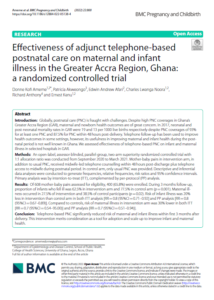
Introduction: Globally, postnatal care (PNC) is fraught with challenges. Despite high PNC coverages in Ghana’s Greater Accra Region (GAR), maternal and newborn health outcomes are of great concern. In 2017, neonatal and post-neonatal mortality rates in GAR were 19 and 13 per 1000 live births respectively despite PNC coverages of 93% for at least one PNC and 87.5% for PNC within 48 hours post-delivery. Telephone follow-up has been used to improve health outcomes in some settings, however, its usefulness in improving maternal and infant health during the postnatal period is not well known in Ghana. We assessed effectiveness of telephone-based PNC on infant and maternal illness in selected hospitals in GAR.
Methods: An open-label, assessor-blinded, parallel-group, two-arm superiority randomized controlled trial with 1:1 allocation ratio was conducted from September 2020 to March 2021. Mother-baby pairs in intervention arm, in addition to usual PNC, received midwife-led telephone counselling within 48 hours post-discharge plus telephone access to midwife during postnatal period. In control arm, only usual PNC was provided. Descriptive and inferential data analyses were conducted to generate frequencies, relative frequencies, risk ratios and 95% confidence intervals. Primary analysis was by intention-to-treat (ITT), complemented by per-protocol (PP) analysis.
Results: Of 608 mother-baby pairs assessed for eligibility, 400 (65.8%) were enrolled. During 3 months follow-up, proportion of infants who fell ill was 62.5% in intervention arm and 77.5% in control arm (p = 0.001). Maternal illness occurred in 27.5% of intervention and 38.5% of control participants (p = 0.02). Risk of infant illness was 20% less in intervention than control arm in both ITT analysis [RR = 0.8 (95%CI = 0.71-0.92] and PP analysis [RR = 0.8 (95%CI = 0.67-0.89)]. Compared to controls, risk of maternal illness in intervention arm was 30% lower in both ITT [RR = 0.7 (95%CI = 0.54-95.00)] and PP analysis [RR = 0.7 (95%CI = 0.51-0.94)].
Conclusion: Telephone-based PNC significantly reduced risk of maternal and infant illness within first 3 months after delivery. This intervention merits consideration as a tool for adoption and scale up to improve infant and maternal health.